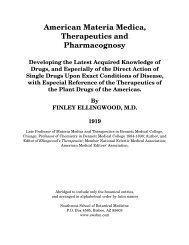SCARLET FEVER. Synonyms.—Scarlatina; Scarlet Rash. Definition ...
SCARLET FEVER. Synonyms.—Scarlatina; Scarlet Rash. Definition ...
SCARLET FEVER. Synonyms.—Scarlatina; Scarlet Rash. Definition ...
Create successful ePaper yourself
Turn your PDF publications into a flip-book with our unique Google optimized e-Paper software.
and during the period of desquamation.<br />
Predisposing Cause.—Age.—While no age is exempt, it is essentially a<br />
disease of childhood. Infants are not so liable to contract the disease,<br />
although cases have been recorded where the child was born with it.<br />
The ages most susceptible are between two and eight years. After ten<br />
the susceptibility diminishes, very few indeed contracting the disease<br />
after reaching adult life.<br />
The great value of isolation is thus seen; for if one can protect the child<br />
until he is ten years old, but little danger exists. Neither sex nor race<br />
seems to influence the predisposition. Social position seems to have but<br />
little influence, the rich and favored suffering alike with the- poor.<br />
Season.—Autumn and winter show a greater number of cases than<br />
spring and summer.<br />
Wounds.—Open wounds, either accidental or surgical, increase the<br />
susceptibility to the poison.<br />
Pathology.—There are no characteristic or specific changes to record,<br />
the changes which do take place in the viscera being-the same as are<br />
found in all fevers of an intense character. The blood is dark, diffluent,<br />
and does not coagulate readily, owing to a defect in the fibrin.<br />
Should death be delayed to an advanced stage of the disease, it is<br />
usually the result of septicemia, nephritis with dropsy, or the result of<br />
an endocarditis, pericarditis, or meningitis.<br />
The eruption is due to the hyperemia of the skin during the dermatitis,<br />
and disappears after death, except in those malignant cases where the<br />
eruption failed to appear during life, and appears upon the death of the<br />
patient, confirming the diagnosis.<br />
The change which takes place in the throat resembles that of simple<br />
inflammation, tonsillitis, or cynanche maligna. In some, only the<br />
superficial tissues are involved, as may be seen by the vivid redness,<br />
while in others the inflammation assumes a phagedenic character,<br />
dipping down into the deeper tissues, which, sloughing, reveal ragged<br />
and foul-looking ulcers. Extending to the deeper tissues of the neck,<br />
large abscesses may form. The cervical glands become involved in the<br />
malignant form, and occasionally suppurate, leaving ugly, cold<br />
The Eclectic Practice of Medicine - PART I - Infectious Diseases - Page 127

















